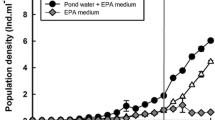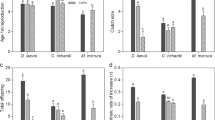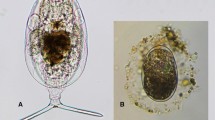Abstract
We studied the patterns of population growth of 7 cladoceran species (Alona rectangula, Ceriodaphnia dubia, Daphnia laevis, Diaphanosoma brachyurum, Moina macrocopa, Scapholeberis kingi and Simocephalus vetulus) using 6 algal densities, viz. 0.05×106, 0.1×106, 0.2×106, 0.4×106, 0.8×106 and 1.6×106 cells ml−1, of Chlorella vulgaris for 18 – 30 days. In terms of carbon content these algal concentrations corresponded to 0.29, 0.58, 1.16, 2.33, 4.65 and 9.31 μg ml−1, respectively. Cladocerans in the tested range of algal levels responded similarly, in that increasing the food concentrations resulted in higher numerical abundance and population growth rates (r). The peak population densities were (mean±standard error) 71±5; 17.1±0.4, 3.6±0.3, 12.7±1.1, 18.2±2.7, 15.8±1.0 and 10.9±0.02 ind. ml−1, respectively for A. rectangula, C. dubia, D. laevis, D. brachyurum, M. macrocopa, S. kingi and S. vetulus. In general, the lowest r values were obtained for D. laevis (0.01±0.001) at 0.05×106 cells ml−1 food level while the highest was 0.283±0.004 for A. rectangula at 1.6×106 cells ml−1 of Chlorella. When the data of peak population density for each cladoceran species were plotted against the body length, we found an inverse relation, broadly curvilinear in shape. From regression equations between the food level and rate of population increase, we calculated the theoretical food quantity (the threshold level) required to maintain a zero population growth (r = 0) for each cladoceran species, which varied from 0.107 to 0.289 μg ml−1 d−1 depending on the body size. When we plotted the cladoceran body size against the corresponding threshold food levels, we obtained a normal distribution curve. From this it became evident that for up to 1300 μm body size, the threshold food level increased with increasing body size; however, beyond this, the threshold level decreased supporting earlier observations on rotifers and large cladocerans.
Similar content being viewed by others
References
Alva-Martínez, A. F., 2001. Crecimiento poblacional de tres especies de cladóceros (Daphnia pulex, Moina macrocopa y Ceriodaphnia dubia) utilizando una cianobacteria (Microcystis aeruginosa) y un alga verde (Chlorella vulgaris) como alimento. M. Sc. Thesis, UNAM, Mexico.
Alva-Martínez, A. F., S. S. S. Sarma & S. Nandini, 2001. Comparative population dynamics of three cladoceran species (Cladocera) in relation to different levels of Chlorella vulgaris and Microcystis aeruginosa. Crustaceana 78: 749-764.
Dodson, S. I. & D. G. Frey, 1991. Cladocera and other branchiopoda. In Thorp, J. H. & A. Covich (eds), Ecology and Classification of North American Freshwater Invertebrates. Academic Press, San Diego, U.S.A.: 732-776.
Downing, J. A. & F. H. Rigler (eds), 1984. A Manual for the Methods of Assessment of Secondary Productivity in Fresh Waters. 2nd edn. IBP Handbook 17. Blackwell Scientific Publ. London.
Dumont H. J., S. S. S. Sarma & A. J. Ali, 1995. Laboratory studies on the population dynamics of Anuraeopsis fissa (Rotifera) in relation to food density. Freshwat. Biol. 33: 39-46.
Gilbert, J. J., 1988. Suppression of rotifer populations by Daphnia a review of the evidence the mechanisms and the effects on zooplankton community structure. Limnol. Oceanogr., 33 (6 Part 1): 1286-1303.
Glazier, D. S. & P. Calow, 1992. Energy allocation rules in Daphnia magna: clonal and age differences in the effects of food limitation. Oecologia 90: 540-549.
Gliwicz, Z. M., 1990. Food thresholds and body size in cladocerans. Nature 343: 638-640
Gliwicz, Z. M., 2001. Species-specific population-density thresholds in cladocerans? Hydrobiologia 442: 291-300
Gliwicz, Z. M. & W. Lampert, 1990. Food thresholds in Daphnia species in the absence and presence of blue-green filaments. Ecology 71: 691-702.
Hardy, E. R. & A. Duncan, 1994. Food concentration and temperature effects on life cycle characteristics of tropical cladocera (Daphnia gessneri Herbst, Daiphanosoma sarsi Richard, Moina reticulata (Daday)): 1. Development time. Acta Amazonica 24: 119-134.
Krebs, C. J., 1985. Ecology. The Experimental Analysis of Distribution and Abundance. 3rd edn. Harper & Row, New York.
Lampert, W. & U. Sommer, 1997. Limnoecology: The Ecology of Lakes and Streams. Oxford University Press, New York.
McNair, J. N., M. E. Boraas & D. B. Seale, 1998. Size-structure dynamics of the rotifer chemostat: a simple physiologically structured model. Hydrobiologia 387/388: 469-476.
Nandini, S. & T. R. Rao, 1998. Somatic and population growth in selected cladoceran and rotifer species offered the cyanobacterium Microcystis aeruginosa as food. Aquat. Ecol. 31: 283-298.
Nandini, S. & S. S. S. Sarma, 2000. Lifetable demography of four cladoceran species in relation to algal food (Chlorella vulgaris) density. Hydrobiologia 435: 117-126.
Nandini, S. & S. S. S. Sarma, 2002. Competition between Moina macrocopa and Ceriodaphnia dubia: a life table demography study. Int. Rev. Hydrobiol. 87: 85-95.
Naylor, C. M. C. Bradkey & P. Calow, (1992). Effect of algal ration, quality and method of quantification on growth and reproduction of Daphnia magna. Arch. Hydrobiol. 125: 311-321.
Pandian, T. J. & F. J. Vernberg (eds), 1987. Animal Energetics. 1. Protozoa through Insecta. Academic Press, London.
Sarma, S. S. S., 1987. Experimental studies on the ecology of Brachionus patulus (Müller) in relation to food, temperature and predation. Doctoral thesis, University of Delhi, Delhi, India.
Sarma, S. S. S., M. A. Fernández-Araiza & S. Nandini, 1999. Competition between Brachionus calyciflorus Pallas and Brachionus patulus (Müller) (Rotifera) in relation to algal food concentration and initial population density. Aquat. Ecol. 33: 339-345
Sarma, S. S. S., N. Iyer & H. J. Dumont, 1996. Competitive interactions between herbivorous rotifers: importance of food concentration and initial population density. Hydrobiologia 331: 1-7.
Sarma, S. S. S., R. A. A. Stevenson & S. Nandini, 1998. Influence of food (Chlorella vulgaris) concentration and temperature on the population dynamics of Brachionus calyciflorus Pallas (Rotifera). Ciencia Ergo Sum 5: 77-81.
Sokal, R. R. & F. J. Rohlf, 1981. Biometry, 2nd edn. W.H. Freeman and Company, San Francisco.
Stemberger, R. S. & J. J. Gilbert, 1985a. Assessment of threshold food levels and population growth in planktonic rotifers. Arch. Hydrobiol. Beih. 21: 269-275.
Stemberger, R. S. & J. J. Gilbert, 1985b. Body size, food concentration and population growth in planktonic rotifers. Ecology 66: 1151-1159.
Author information
Authors and Affiliations
Rights and permissions
About this article
Cite this article
Nandini, S., Sarma, S. Population growth of some genera of cladocerans (Cladocera) in relation to algal food (Chlorella vulgaris) levels. Hydrobiologia 491, 211–219 (2003). https://doi.org/10.1023/A:1024410314313
Issue Date:
DOI: https://doi.org/10.1023/A:1024410314313




